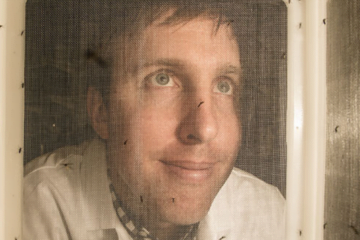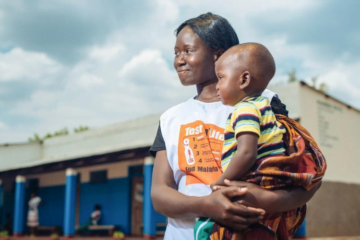In April 2019, Malawi made global health history.
It became the first country to introduce RTS,S – the world’s first malaria vaccine – in what’s known as a pilot implementation programme. Two other African countries, Ghana and Kenya, followed suit, also introducing the vaccine before the year came to a close.
So how does the vaccine work?
RTS,S aims to neutralise P. falciparum malaria parasites in the bloodstream before they reach the liver, where they start a chain of events that ultimately cause disease symptoms. The vaccine is not a magic bullet, though. Individuals need four doses of the vaccine over 18 months to achieve optimum efficacy. Even then, it only works 40% of the time. This vaccine is important, though. It’s the first vaccine to be recommended for pilot implementation by the World Health Organisation.
To discuss RTS,S, and the global health challenges surrounding it, in terms of adherence and hesitancy, I’m joined today by Dr Ashley Birkett. He’s the Director of the Malaria Vaccine Initiative at PATH. It’s a platform that aims to accelerate the development of vaccines for malaria.
I began by asking Dr Birkett about the different types of malaria vaccine.
Malaria is caused by Plasmodium parasites that have a very complex life-cycle and we try to target different stages of their life-cycle with vaccine approaches. There are primarily three different life-cycle stages that we target with vaccines. The first one is called the pre-erythrocytic stage, which is the stage of the parasite life cycle before it enters the blood. When it enters the blood is when you start to get the clinical symptoms of malaria. So when you get bitten by an infectious mosquito, the mosquito deposits parasites that are called sporozoites into the skin and that initiates the infection. Once those sporozoites get to the liver, they develop over the course of a week or so and, during that time, there are no symptoms whatsoever so you don’t know that you’re infected. But once the parasite emerges from the liver into the blood, a few days later, is when you start to see the clinical signs of malaria.
The parasite’s not done there with the blood stage, it continues to evolve into different forms which are then picked up by mosquitoes that feed on that infected individual. And then those can then develop in the mosquito and then transmit the parasite back on to additional humans. So it’s a very complex life-cycle and we aim to target different stages of the life-cycle through vaccine approaches. So either the pre-erythrocytic in the skin or in the liver, the blood stages to prevent the clinical symptoms or what we call transmission-blocking to prevent the transmission of the parasite back onto mosquitoes from that infected human. Some new approaches are looking at combining multiple stages, so-called multi-stage vaccines where you might try and combine two or three different vaccine approaches, targeting those through different stages into a single vaccine approach. That’s one of the more ambitious approaches that’s currently under evaluation.
The vaccine most far down the pipeline is the RTS,S vaccine. Could you talk to me about how that came about?
The RTS,S vaccine has had a long history. It’s been in development for about 30 years now, a testament to the challenge in developing a vaccine against malaria. We have no vaccines in widespread use against parasites in humans, so this is very much uncharted territory. The initial data that suggested that the vaccine might be possible against malaria came in the 1960s, when it was shown that if you took sporozoites – that form of the parasite that comes in on an infectious blood meal from a mosquito – and weaken them and then use them as a vaccine, it was possible to induce protective responses in laboratory animals. And over the course of the next few decades, we figured out – and this was primarily work done at New York University – which pieces, which specific proteins on the surface of those sporozoites, could be responsible for that immunity. And so in the 1980s, a partnership between Walter Reed Army Institute in the US and GlaxoSmithKline (GSK) started to work on leveraging that information towards the development of what we call a subunit vaccine, a vaccine which takes just a piece of the pathogen and delivers it to the immune system in the most effective way possible. PATH got involved in that project around the year 2000 and was intimately involved in much of the clinical testing, including in sub-Saharan Africa of that vaccine approach. And then in 2015, in partnership with our partners in Africa and GlaxoSmithKline, reported data from a very large Phase 3 clinical trial in 11 clinical centres in seven sub-Saharan African countries that reported that the vaccine could reduce the incidence of clinical malaria by about 40% over four years in younger African children, and perhaps even more importantly could reduce the incidence of severe malaria by about 30% in those children.
But it’s not a magic bullet, though, because for maximum efficacy, it requires four doses over 18 months. How would you ensure adherence to that vaccine schedule, given that many recipient communities likely won’t have well-developed health care structures?
It’s a very good point. Obviously, we’d like to have as few doses as possible if we can protect with a single dose, that’s fantastic. But as you mentioned, the healthcare systems in countries where malaria continues to be a problem are quite weak, and this is the main challenge. We know malaria is preventable, it’s treatable. Nobody should be dying from malaria today. But unfortunately, the health systems in many countries around the world, particularly sub-Saharan Africa, are not as strong as they might be, and we’re still seeing over 400,000 deaths from malaria every year, primarily in young children. So a vaccine provides a unique opportunity because we’re able to leverage an existing system, which is highly effective even in some of the poorest countries in the world. So, for example, very poor countries that may not have the health systems in place that enable effective diagnosis and treatment of malaria still may be able to deliver vaccines quite effectively. We see, even in some of the poorest countries in sub-Saharan Africa, 80% adherence to vaccine delivery. So 80% of the children are getting vaccinated, even though they may not have access to very well-developed health systems. So this is an opportunity to leverage stronger immunisation systems with a vaccine that’s been shown to be effective in a large Phase 3 clinical trial to try to reduce the burden from malaria in sub-Saharan Africa.
The efficacy for RTS,S stands at around 40%. Are there efforts to improve that? Is it conceivable that, further down the line, we’ll see a more efficacious vaccine come out for clinical trials?
So work is ongoing. As RTS,S gets rolled out in a large and implementation program across three countries in sub-Saharan Africa – in Ghana, Malawi and Kenya – we hope the vaccine is going to reach about a million children over the next three years. But work is ongoing to try and develop a more effective malaria vaccine. I personally think we’re 5-10 years away from a better vaccine, so I think we have to maximise the capabilities of the tools we have. That includes vaccines like RTS,S, which has been proven to be safe and efficacious in a large Phase 3 clinical trial. But work is ongoing and we’re involved in some of that work at PATH. There are probably three main approaches to develop more effective vaccines. One is to continue to learn about the RTS,S vaccine and how to best to deploy it. While it is being used in many thousands of children and evaluated in many thousands of children, and we know a lot about the vaccine around its efficacy and safety profile, we can still learn lessons on how best to deploy it, and so work is ongoing to continue to learn to see if we can deploy or to assess more effectively in the long run. There’s the potential that we could add the additional components to the vaccine and to make it more efficacious or totally new vaccine approaches, including some that are being leveraged by the learnings about RTS,S, are in development. But, I would say we’re probably 5-10 years away from something that could conceivably be significantly better than the RTS,S vaccine.
We hear an awful lot in the press about anti-vax movements and vaccine hesitancy. How much of a problem is vaccine hesitancy in recipient communities, and how do you try and overcome that?
We’re certainly aware of the challenges in the US and Europe with vaccine hesitancy and that is often driven by misinformation, unfortunately. And we are starting to see that misinformation spreading to low to middle-income countries, particularly with the launch of new vaccines. We monitor this closely, particularly when new vaccines are being introduced. We have people working in those countries who have very close contact with the communities that we are serving. And we work very hard to ensure that the key stakeholders and the partners and the community have access to the latest and most accurate information about the vaccines that are being used, particularly through the introduction phase. It’s a very important part of our work and we continue to work very hard to ensure that the correct information is getting out.
On the subject of vaccines in general. Why are they preferable to other methods of malaria prevention, like seasonal malaria chemoprevention, where efficacy stands at around 75%, and its use is less resource-intensive.
One of the things we’ve learnt about malaria over the years is there is no silver magic bullet that’s going to beat malaria. It’s really about taking imperfect tools and applying them as best we can to have maximum effect. Fortunately, we have a suite of different tools that have proven to be efficacious, insecticide-treated bed nets among them. And so it’s really about layering those tools on top of each other and adapting them most effectively to the environments in which we’re using them. Delivery is a very important piece of this. As I mentioned previously, vaccines really benefit from the fact that we have infrastructures in place that are highly effective in getting vaccines at high coverage levels to some of the poorest people in the world. So I think we’re fortunate in the vaccine space that we’re able to leverage that existing platform for getting vaccines out there effectively and ensuring high coverage. Unfortunately, that isn’t necessarily the case for all of the interventions that we work on. Even though they might, on the face of it, look highly desirable with many features. That delivery aspect can often be very challenging, we leverage that to maximum effect with vaccines.
So ideally, you won’t just be using vaccines as a single control measure, you’ll be using them in conjunction with mosquito nets and insecticide spraying as well.
Absolutely. That’s a very important message as the vaccine is getting introduced in the three pilot countries. That the parents of children and caregivers continue to use bed nets, continue to seek treatment for children that they think might be infected. It’s a really important part of the pilot introduction to reinforce the importance of continuing to use the existing control measures and see the RTS,S vaccine as a supplemental measure on top of what’s already working to some degree in sub-Saharan Africa.
You’re the director of PATH Malaria Vaccine Initiative. What is the role of that organisation in vaccine development?
PATH has a rich history in developing vaccines and ensuring access in low and middle-income countries. We have an end-to-end operating model, which enables us to engage at the very earliest stage of vaccine development, which we call the discovery phase, which is often engaging with academic researchers or biotech companies who are discovering new vaccines. We’re involved at that stage. We then continue to remain involved as we advance vaccines through the development stages. So typically the phased clinical trials of increasing size, as vaccines go through development, and then through the introduction, as we’re seeing with the RTS,S assess vaccine, were obviously key players in the introduction of vaccines across low and middle-income countries. Another key piece of our work is access, ensuring that vaccines are going to be accessible to those who will benefit most from them. We’re really involved at PATH in all stages of vaccine development from the very beginning, the discovery, all the way through introduction and ensuring access.
Given the birth of new technologies like CRISPR gene editing, better surveillance tool and even Artificial Intelligence. Are you convinced that vaccines are the best way to reduce malaria prevalence?
I don’t think we can say today that malaria vaccines are the best way to reduce malaria prevalence. We know that no single tool is going to be effective again in the battle against malaria – it’s probably more of a war than a battle. But no, it’s not about a single tool. It’s about layering multiple tools on top of each other – all of them in perfect – but trying to use them most effectively to win the war against malaria. So we’re excited about new approaches that are coming through, whether that’s CRISPR technology, gene editing and all of these offers significant promise. But I think it’s important to remember that we have a lot of tools that offer promise. And we have unfortunately a smaller, limited number of tools that have been proven to have efficacy in preventing malaria. And in the RTS,S malaria vaccine, we have one additional tool that’s been proven in a large Phase 3 clinical trial that it can have an impact against malaria and we look forward to seeing what impact that is in the long term. But certainly, we welcome the continued research and hopefully introduction of new and innovative tools over the coming years.
Dr Ashley Birkett of PATH MVI, thank you.
Thank you very much for your time.
Image Credit: PATH


